Little known outside Wales and Great Britain, the secluded Welsh shrine of St. Melangel, deep in the Berwyn Mountains, is dedicated to a sixth-century Irishwoman, an anchorite who lived here for many years, alone and unknown. An early Christian treasure, it is the oldest existing Romanesque shrine in northern Europe. When the church was restored in the 1960’s, Melangell’s relics were discovered under the chapel floor, and now more than 10,000 pilgrims a year come to ask for her intercession.
The shrine of Pennant Melangell, consisting of the church and a few small houses, is situated in a place of great natural beauty deep in the Berwyn Mountains. The small river, Tanat, runs by a narrow lane from the nearby village of Llangynog into a quiet green valley surrounded by high hills and the rugged promontory of Moel Ddu Maw (Moel Dimoel). For most of the year, powerful waterfalls cascade down the cliff-sides.
A Christian church and pilgrimage site for over 1200 years, the former Bronze Age site is ringed by ancient yew trees estimated to be over two thousand years old. A Bronze Age pre-Christian community erected a wall in the midst of the oak forest, which covered the valley, and they found safety hidden in this remote place.
Little is known about St. Melangell beyond the bare tradition that she was a daughter of the royal house of Strathclyde, and came from Ireland at the beginning of the 7th century to convert the Welsh and set up a small religious settlement. Such fragmentary information, however, only makes it apparent that her presence and her prayer must have been quite extraordinary, as attested to by the devotion the Welsh people have always paid her, even following the Reformation.
The Norman church, parts of which date from the twelfth century, is dedicated to St. Melangell (in Latin, Monacella), and incorporates materials of an even older shrine. The present stone church and reliquary-shrine, replacing older wooden structures, were built c. 1100 by order of the king in thanksgiving for peace in his lands and because, by that time, the saint herself had become extremely important in Welsh life.1 In 1450, an oak screen was installed, separating the nave from the chancel, and elaborately carved with the traditional account of the meeting of Melangell and Prince Brychwel. A great oak carving of Christ on the cross was also installed, although this cross was later destroyed and a replacement in bronze now hangs in its place. One of the two medieval effigies near the rebuilt shrine is thought to represent St. Melangell herself. The original Norman font was later joined by a Georgian pulpit, a chandelier, a commandment board, and a series of stone carvings of Melangell’s hare by the sculptor Meical Watts.
The entrance to the shrine bears the inscription, Perindod Melangell, “Melan- gell’s Pilgrimage,” and above the gate is a poem inscribed in Welsh: “Lean purely towards prayer in your heart. Take care when praising God; God only is good, and it is good to give Him honor here.”
In 1537, during the Reformation, the shrine and reliquary were removed by local Christians and hidden in the three-foot exterior walls of the church to prevent destruction. In 1630, the western tower was added, along with a square room (possibly a hermitage) against the exterior east end of the church’s sturdy three-foot thick walls. 1876 saw the tower rebuilt, a new roof, and some interior work. Another restoration followed in 1958 and part of the shrine was removed from the outer walls and badly erected in the interior of the former church—then the village school room. From 1989 to 1992, the church was fully and faithfully restored under the guidance of architects, historians, archivists, and builders. Saint Melangell’s Romanesque reliquary-shrine, beneath which her relics are laid, wasalso restored along with the church. This is the oldest Romanesque shrine in northern Europe. In the Middle Ages, pilgrims in search of healing were laid beneath the stone reliquary canopy.
At the start of the restoration, Rev. Paul and Evelyn Davies moved into a tiny cottage beside the church to oversee the work and Evelyn organized the appeals campaign that eventually raised £300,000. The church was rededicated on July 28, 1992 by the Anglican Archbishop of Wales and has since been an important site for pilgrims— approximately 10,000 a year come for prayer. In 1994, Evelyn built the Cancer Help Centre in the garden and many healings have taken place at the shrine. Anglican, Catholic, and Orthodox pilgrims come to venerate the relics and to pray; the ministry continues today for all Christians.
Dr. William Morgan, translator of the Bible into Welsh, was the rector of Pennant Melangell from 1588-1595. Nearby Llangynog was later a well-known centre of harp-making. Both Thomas Lloyd, an early-20th-century quarry worker at Llangynog and winner of competitions for both harp-making and playing, and internationally-famous Welsh harpist Nancy Richards, are buried at Pennant Melangell.
The well-known story of Melangell and the hare comes down to us from the Welsh oral tradition through carvings, songs, and poetry, some only recently discovered and translated.
St. Melangell and the Hare
In early 7th-century Wales (Powys), there lived in the town of Pengwern Powys (now Shrewsbury), Prince Brychwel Ysgithrog, also Earl of Chester, whose dwellings were located where the later College of St. Chad would stand, nine miles from today’s Welsh border. The prince was known to give generous alms for the service of God and the poor.
One day in 604 AD, Brychwel went hunting in a remote area of his principality called Pennant. When his dogs started a hare, the prince, shouting encouragement, pursued it on horseback into a thorny bramble thicket, but instead of retrieving the hare, the dogs fled howling. In the midst of the brambles he came upon a clearing in which a beautiful woman stood deep in prayer, the hare lying boldly under the hem of her garment. Seeing the woman, the astonished prince asked how long she had lived alone in such a wilderness. According to the medieval Latin sources, she replied, “For the past fifteen years, I have not looked on the face of a man.” “But whose daughter art thou, and from where hast thou come? “I am from Ireland,” she replied, “the daughter of a king, and because my father decreed that I was to be given as wife to a nobleman of Ireland, by God’s leading, I came here instead, to serve God and the spotless Virgin with a pure body and heart for as long as I remain on earth.”
The prince asked the woman’s name, to which she replied, “Melangell.”2 After considering her state of life, her well-being, and her solitude, the prince replied, “Most worthy Melangell, I perceive that thou art a handmaid of the true God. Because it hath pleased Him for thy merits to give protection to this little wild hare from the attack and pursuit of the hounds, I give and present to thee with willing mind these my lands for the service of God, to be a perpetual asylum and refuge. If any men or women flee hither to seek thy protection, provided they do not pollute thy sanctuary, let no prince or chieftain be so rash towards God as to attempt to drag them forth.”3 Another version adds, “If, on the other hand, any guilty person enjoying your sanctuary shall go out to do any kind of wrong, then let those governing your sanctuary who know of these wrongs, deliver them to the officials of Powys.”
Melangell continued her solitary life near Pennant for over thirty-seven years. The wild hares befriended her throughout her life, and were ever after called Wyn Melangell (St. Melangell’s lambs). Other chaste women settled nearby [who may have come with her from Ireland], to live together out of love of God, intent upon prayer and divine services.
After the death of the illustrious Prince Brychwel, his son Tysilio held the principality of Powys; then Cynan, Tysilio’s brother, and afterwards, Tambryd, Curmylk, and Durres the Lame. All of these decreed that the place of Pennant Melangell should remain a perpetual sanctuary for those devoted to God and the needy, confirming the acts of the prince.
After Melangell departed from this life in 607,4 a nobleman by the name of Elise came to Pennent Melangel, who, desiring to ravish and defile the virgins, came to a wretched end and perished suddenly. From that time on, whoever violated the liberty or holy order of this place rarely escaped divine vengeance.
So strong a tradition of her influence prevailed that, until this day, no one in the parish of Cwm Pennant will kill a hare, and for centuries, if a hare was pursued by dogs, it was firmly believed that if anyone cried, Duw A Melangell A’th Gadwo (“God and Melangell preserve thee!”), the hare was sure to escape.
Her festival is May 27.
The following play on her name was ancient even when it was recorded in Welsh in the registry of the church in 1723:
Mil engyl a Melangell Trechant
lu fyddin y fall.
Melangell with a thousand angels
Triumphs over all the powers of evil.
From: Road to Emmaus #36.

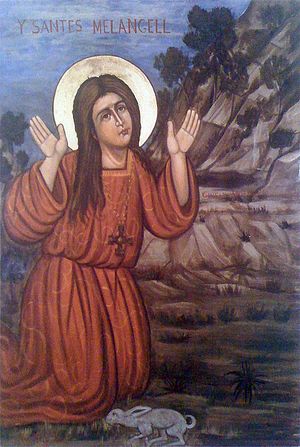
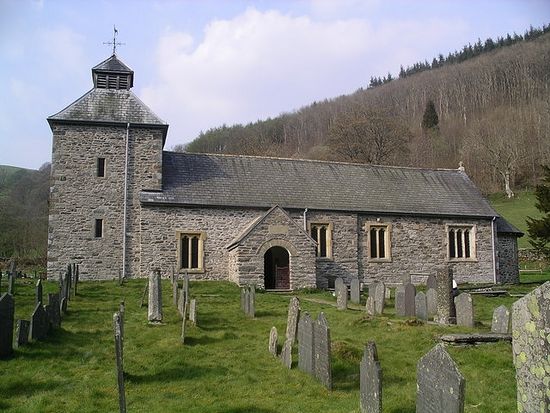
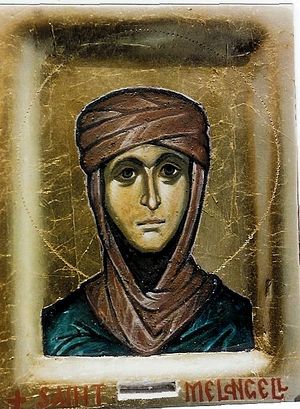
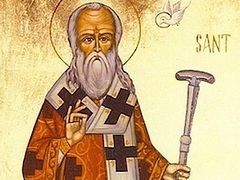
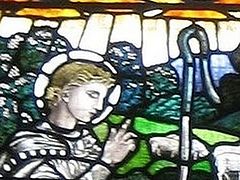
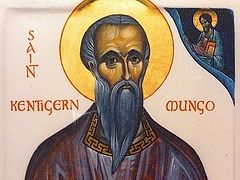
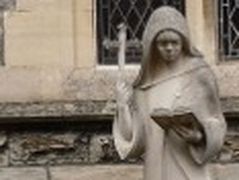
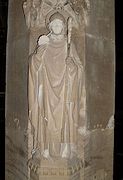
Please, could you explain why St Melangell appears in your Calendar on May 17 (30 May New Style), and this article by Nun Necatria (McLees) states clearly that St Melangell is commemorated on 27 May (which would be 9 June New Style).
In XC, Mother Melangell